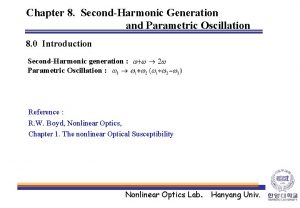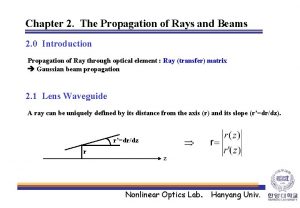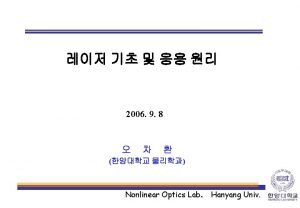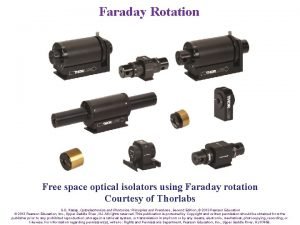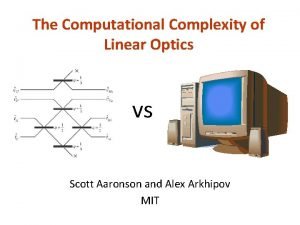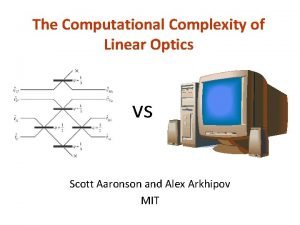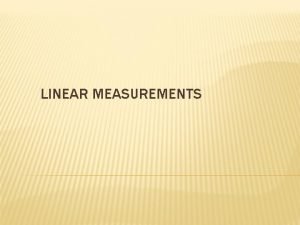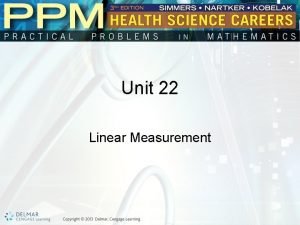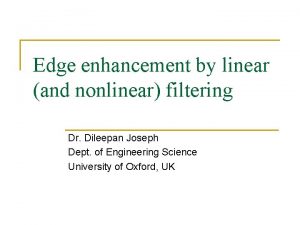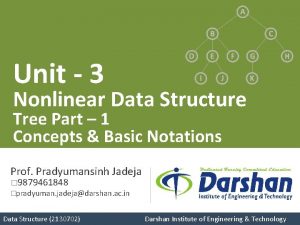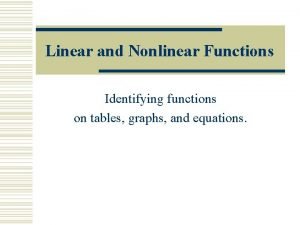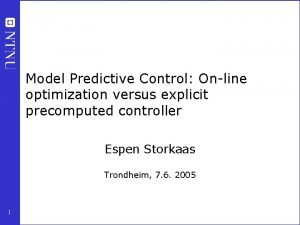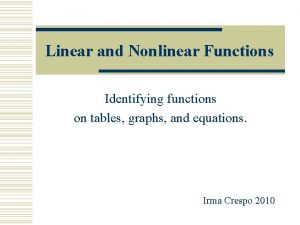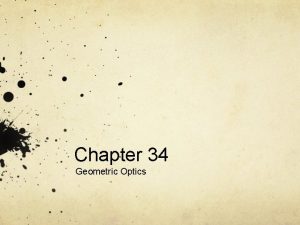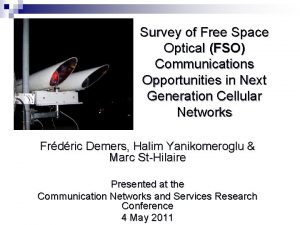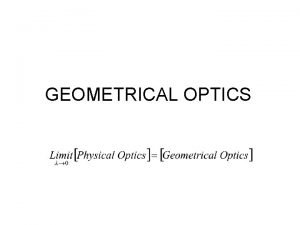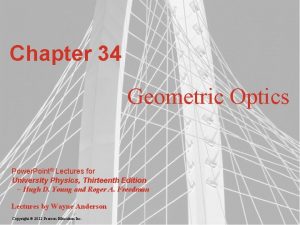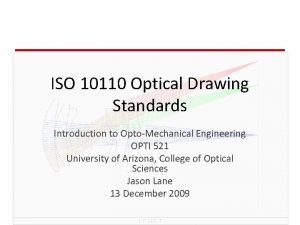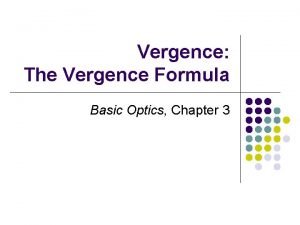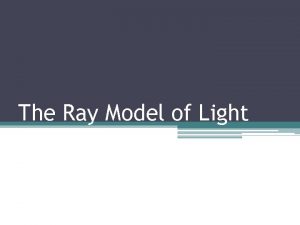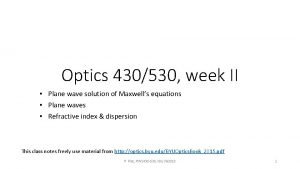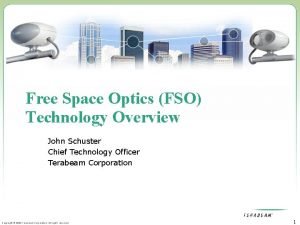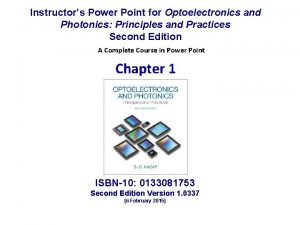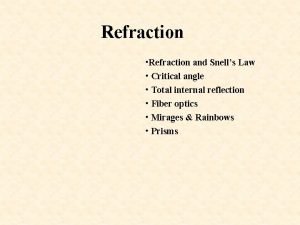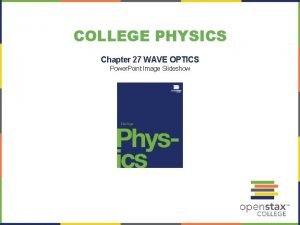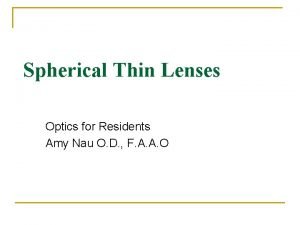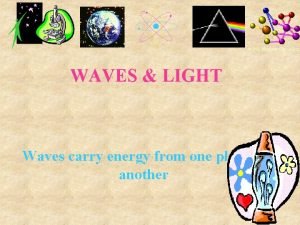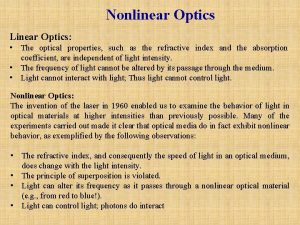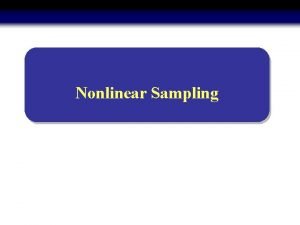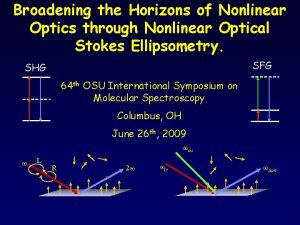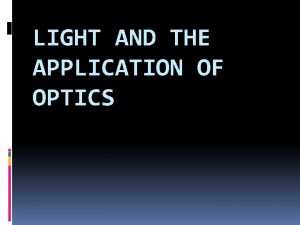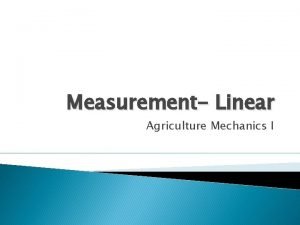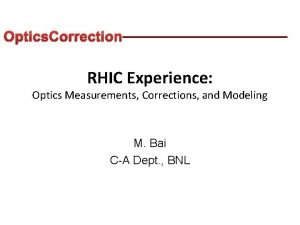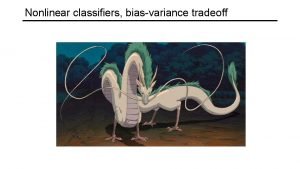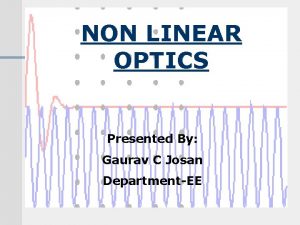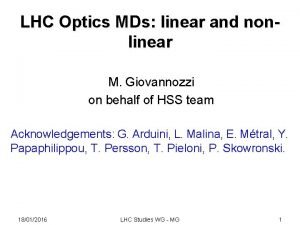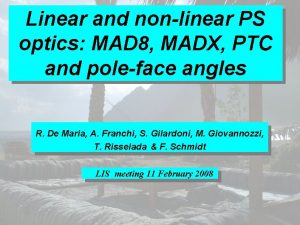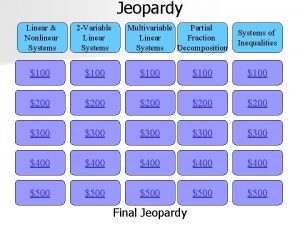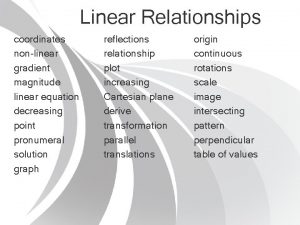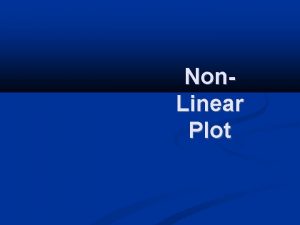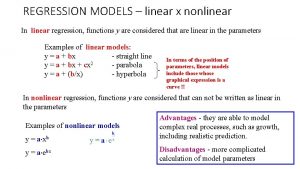Recent measurements of linear nonlinear optics at the





































































- Slides: 69

Recent measurements of linear & nonlinear optics at the ESRF storage ring Andrea Franchi (ESRF, Grenoble) on behalf of the Beam Dynamics & Diagnostics groups TW-DULER 2018, DIAMOND, 19 th -20 th April 2018

Outlines • Where we were in 2016 • Fast measurement and analysis of the orbit response matrix (ORM) • Measuring ultra-low coupling via turn-by-turn (Tb. T) BPM data • Calibrating sextupole magnets via chromatic functions and off-momentum ORM • Accuracy studies • Extra: dealing with “multiple beams” • Measuring momentum compaction: see Laura Torino’s talk Andrea Franchi Optics Measurements @ ESRF

Outlines • Where we were in 2016 • Fast measurement and analysis of the orbit response matrix (ORM) • Measuring ultra-low coupling via turn-by-turn (Tb. T) BPM data • Calibrating sextupole magnets via chromatic functions and off-momentum ORM • Accuracy studies • Extra: dealing with “multiple beams” • Measuring momentum compaction: see Laura Torino’s talk Andrea Franchi Optics Measurements @ ESRF

Where we were in 2016 • Linear optics measured & corrected weekly via ORM (10’+15’ , no need of switch BPM in Tb. T mode, works for any sextupolar optics, i. e. filling mode) => rms β-beat ~4 -5% 32 correctors ultra-low coupling εy/εx~1‰ 64 correctors PRSTAB 14, 034002 (2011) Andrea Franchi Optics Measurements @ ESRF

Where we were in 2016 • Linear optics measured & corrected weekly via ORM (10’+15’ , no need of switch BPM in Tb. T mode, works for any sextupolar optics, i. e. filling mode) => rms β-beat ~4 -5% ultra-low coupling εy/εx~1‰ • Measuring ultra-low coupling with Tb. T BPM data with kicked beam unsuccessful because of the low signal/noise of the coupling line in the Tb. T spectrum Andrea Franchi Optics Measurements @ ESRF

Where we were in 2016 • low kick • Linear optics measured & corrected weekly 1 mm via @ORM βx=35 m • nonlinearities (10’+15’ , no need of switch BPM in Tb. T mode, avoided works for any sextupolar optics, i. e. filling mode) =>line • coupling ~ background rms β-beat ~4 -5% ultra-low coupling noise εy/εx~1‰ • Measuring ultra-low coupling with Tb. T BPM data with kicked beam unsuccessful because of the low signal/noise of the coupling line in the Tb. T spectrum • large kick 3 mm@βx=35 m • nonlinearities pollute lines • coupling line >> background noise arxiv. org: 1603. 00281 Andrea Franchi Optics Measurements @ ESRF

Where we were in 2016 • Linear optics measured & corrected weekly via ORM (10’+15’ , no need of switch BPM in Tb. T mode, works for any sextupolar optics, i. e. filling mode) => rms β-beat ~4 -5% ultra-low coupling εy/εx~1‰ • Measuring ultra-low coupling with Tb. T BPM data with kicked beam unsuccessful because of the low signal/noise of the coupling line in the Tb. T spectrum • nonlinear lattice model and sextupole calibration from harmonic analysis of Tb. T BPM data (~2’, but need BPM in Tb. T mode with MAF filter ~15’x 2, works for a special sextupole optics only, tedious orbit control when calibrating sextupoles) PRSTAB 17 074001 (2014) Andrea Franchi Optics Measurements @ ESRF

Where we were in 2016 from norm. sext. lines to sextupole calibration • Linear optics measured & corrected weekly via ORM (10’+15’ , no need of switch BPM in Tb. T mode, works for any sextupolar optics, i. e. filling mode) => rms β-beat ~4 -5% ultra-low coupling εy/εx~1‰ • Measuring ultra-low coupling with Tb. T BPM data with kicked beam unsuccessful because of the low signal/noise of the coupling line in the Tb. T spectrum • nonlinear lattice model and sextupole calibration from harmonic analysis of Tb. T BPM data (~2’, but need BPM in Tb. T mode with MAF filter ~15’x 2, works for a special sextupole optics only, tedious orbit control when calibrating sextupoles) PRSTAB 17 074001 (2014) Andrea Franchi Optics Measurements @ ESRF

Where we were in 2016 from norm. sext. lines to sextupole calibration • Linear optics measured & corrected weekly via ORM (10’+15’ , no need of switch BPM in Tb. T mode, works for any sextupolar optics, i. e. filling mode) => rms β-beat ~4 -5% ultra-low coupling εy/εx~1‰ • Measuring ultra-low coupling with Tb. T BPM data with kicked beam unsuccessful because of the low signal/noise of the coupling line in the Tb. T spectrum • nonlinear lattice model and sextupole calibration from harmonic analysis of Tb. T BPM data (~2’, but need BPM in Tb. T mode with MAF filter ~15’x 2, works for a special sextupole optics only, tedious orbit control when calibrating sextupoles) PRSTAB 17 074001 (2014) Andrea Franchi Optics Measurements @ ESRF

Where we were in 2016 from norm. lines to&sextupole gradient model • Linear opticssext. measured corrected weeklyerror via ORM (10’+15’ , no need of switch BPM in Tb. T mode, works for any sextupolar optics, i. e. filling mode) => rms β-beat ~4 -5% ultra-low coupling εy/εx~1‰ • Measuring ultra-low coupling with Tb. T BPM data with kicked beam unsuccessful because of the low signal/noise of the coupling line in the Tb. T spectrum • nonlinear lattice model and sextupole calibration from harmonic analysis of Tb. T BPM data (~2’, but need BPM in Tb. T mode with MAF filter ~15’x 2, works for a special sextupole optics only, tedious orbit control when calibrating sextupoles) PRSTAB 17 074001 (2014) Andrea Franchi Optics Measurements @ ESRF

Where we were in 2016 fromoptics skew sext. lines to&sextupole model via ORM • Linear measured correctedtiltweekly (10’+15’ , no need of switch BPM in Tb. T mode, works for any sextupolar optics, i. e. filling mode) => rms β-beat ~4 -5% ultra-low coupling εy/εx~1‰ • Measuring ultra-low coupling with Tb. T BPM data with kicked beam unsuccessful because of the low signal/noise of the coupling line in the Tb. T spectrum • nonlinear lattice model and sextupole calibration from harmonic analysis of Tb. T BPM data (~2’, but need BPM in Tb. T mode with MAF filter ~15’x 2, works for a special sextupole optics only, tedious orbit control when calibrating sextupoles) PRSTAB 17 074001 (2014) Andrea Franchi Optics Measurements @ ESRF

Where we were in 2016 fromoptics norm. measured oct. lines to&octupole field model via (in quads) • Linear corrected weekly ORM (10’+15’ , no need of switch BPM in Tb. T mode, works for any sextupolar optics, i. e. filling mode) => rms β-beat ~4 -5% ultra-low coupling εy/εx~1‰ • Measuring ultra-low coupling with Tb. T BPM data with kicked beam unsuccessful because of the low signal/noise of the coupling line in the Tb. T spectrum • nonlinear lattice model and sextupole calibration from harmonic analysis of Tb. T BPM data (~2’, but need BPM in Tb. T mode with MAF filter ~15’x 2, works for a special sextupole optics only, tedious orbit control when calibrating sextupoles) PRSTAB 17 074001 (2014) Andrea Franchi Optics Measurements @ ESRF

Where we were in 2016 • Linear optics measured & corrected weekly via ORM (10’+15’ , no need of switch BPM in Tb. T mode, ! is s ly a n a ) y il a d ( r e works for any sextupolar quick i. e. filling mode) => we want aoptics, rms β-beat ~4 -5% ultra-low coupling εy/εx~1‰ • Measuring ultra-low coupling with Tb. T BPM data with kicked beam unsuccessful because of the low o it! d o t e k li ’d e w signal/noise of the coupling line in the Tb. T spectrum • nonlinear lattice model and sextupole calibration from harmonic analysis of Tb. T BPM data (~2’, but ! is s ly a n a le ib x le f re filter ~15’x 2, o m & r ie s a e need w BPM in Tb. T mode with MAF n a t e wan works for a special sextupole optics only, tedious orbit control when calibrating sextupoles) Andrea Franchi Optics Measurements @ ESRF

Outlines • Where we were in 2016 • Fast measurement and analysis of the orbit response matrix (ORM) • Measuring ultra-low coupling via turn-by-turn (Tb. T) BPM data • Calibrating sextupole magnets via chromatic functions and off-momentum ORM • Accuracy studies • Extra: dealing with “multiple beams” • Measuring momentum compaction: see Laura Torino’s talk Andrea Franchi Optics Measurements @ ESRF

Fast ORM measurement and analysis • ORM analysis (dip. & quad. errors & tilts) needs to evaluate responses N & S Andrea Franchi Optics Measurements @ ESRF

Fast ORM measurement and analysis • ORM analysis (dip. & quad. errors & tilts) needs to evaluate responses N & S • today: done numerically (compute ORM for each magnet error & tilt) : num@ESRF’ 17 ~2’ x 2 (iterations), 64+256 magnets (existing storage ring) num@ESRF’ 19 ~4’ x 2 (iterations), 128+514 magnets ( new storage ring) Andrea Franchi Optics Measurements @ ESRF

Fast ORM measurement and analysis • ORM analysis (dip. & quad. errors & tilts) needs to evaluate responses N & S • today: done numerically (compute ORM for each magnet error & tilt) : num@ESRF’ 17 ~2’ x 2 (iterations), 64+256 magnets (existing storage ring) num@ESRF’ 19 ~4’ x 2 (iterations), 128+514 magnets ( new storage ring) • Analytic formulas for N & S were derived speeding up their computation analyt@ESRF’ 17 ~2” x 2 (iterations) collaboration with Z. Martí of ALBA analyt@ESRF’ 19 ~4” x 2 (iterations) arxiv. org: 1711. 06589 Andrea Franchi Optics Measurements @ ESRF

Fast ORM measurement and analysis • ORM analysis (dip. & quad. errors & tilts) needs to evaluate responses N & S • today: done numerically (compute ORM for each magnet error & tilt) : num@ESRF’ 17 ~2’ x 2 (iterations), 64+256 magnets (existing storage ring) num@ESRF’ 19 ~4’ x 2 (iterations), 128+514 magnets ( new storage ring) • Analytic formulas for N & S were derived speeding up their computation analyt@ESRF’ 17 ~2” x 2 (iterations) collaboration with Z. Martí of ALBA analyt@ESRF’ 19 ~4” x 2 (iterations) ORM diagonal block line (foc. err. ) ORM off-diagonal block line (coupl. ) Error: ~1 -2% rms No measur. difference in fit & correction of real data arxiv. org: 1711. 06589 Andrea Franchi Optics Measurements @ ESRF

Fast ORM measurement and analysis • Today’s ORM measurement: vary one by one the DC component of 16 x 2 steerers, store de corresponding orbit and infer the ORM => ~10’ (The complete ORM with all 96 x 2 steerers requires ~50’) ~300 μm rms orbit distor. Andrea Franchi Optics Measurements @ ESRF

Fast ORM measurement and analysis • Today’s ORM measurement: vary one by one the DC component of 16 x 2 steerers, store de corresponding orbit and infer the ORM => ~10’ (The complete ORM with all 96 x 2 steerers requires ~50’) ~300 μm rms orbit distor. • As of 2010 @ Diamond Light Source (*) the fast orbit feedback electronics is used to drive simultaneously the AC steerers with a programmable amplitude and frequency and to retrieve the ORM via harmonic analysis => ~43’’ for 172 x 2 steerers (15’ in DC mode) & ~17 μm rms orbit distortion (~170 μm in DC mode) (*) G. Rehm et al. , MOCNB 01@BIW 10, p. 44, TUPRI 083@IPAC 14, … Andrea Franchi Optics Measurements @ ESRF

Fast ORM measurement and analysis • Today’s ORM measurement: vary one by one the DC component of 16 x 2 steerers, store de corresponding orbit and infer the ORM => ~10’ (The complete ORM with all 96 x 2 steerers requires ~50’) ~300 μm rms orbit distor. • As of 2010 @ Diamond Light Source (*) the fast orbit feedback electronics is used to drive simultaneously the AC steerers with a programmable amplitude and frequency and to retrieve the ORM via harmonic analysis => ~43’’ for 172 x 2 steerers (15’ in DC mode) & ~17 μm rms orbit distortion (~170 μm in DC mode) • Since then, AC ORM measurements implemented in other labs (^ nonexhaustive list) (^) X. Yang et al. PRAB 20 054001 (2017), Z. Marti et al. MOPAB 102@IPAC 17, … Andrea Franchi Optics Measurements @ ESRF

Fast ORM measurement and analysis • Today’s ORM measurement: vary one by one the DC component of 16 x 2 steerers, store de corresponding orbit and infer the ORM => ~10’ (The complete ORM with all 96 x 2 steerers requires ~50’) ~300 μm rms orbit distor. • As of 2010 @ Diamond Light Source (*) the fast orbit feedback electronics is used to drive simultaneously the AC steerers with a programmable amplitude and frequency and to retrieve the ORM via harmonic analysis => ~43’’ for 172 x 2 steerers (15’ in DC mode) & ~17 μm rms orbit distortion (~170 μm in DC mode) • Since then, AC ORM measurements implemented in other labs (^ nonexhaustive list) • After first tests in 2012, AC ORM measurements have been resumed in 2017: • measurement: 34’’ for 96 x 2 steerers (7’’x 2+20’’ DS overhead) • orbit distortion: 250 μm rms (H), 25 μm rms (V), to be optimized • 8 steerers in parallel at steps of 2 Hz within 114 Hz & 130 Hz, 0. 5’’ to be repeated 14 times • data analysis duration: 12’ ( 3’x 4 ORM blocks, to be optimized) Andrea Franchi Optics Measurements @ ESRF

Fast ORM measurement and analysis • Today’s ORM measurement: vary one by one the DC component of 16 x 2 steerers, store de corresponding orbit and infer the ORM => ~10’ (The complete ORM with all 96 x 2 steerers requires ~50’) ~300 μm rms orbit distor. • As of 2010 @ Diamond Light Source (*) the fast orbit feedback electronics is used to drive simultaneously the AC steerers with a programmable amplitude and frequency and to retrieve the ORM via harmonic analysis => ~43’’ for 172 x 2 steerers (15’ in DC mode) & ~17 μm rms orbit distortion implementation plan (~170 μm in DC mode) perform it daily after special • Since then, AC ORM measurements implemented in other labs (^ top-up nonbunch cleaning (long exhaustive list) sequence @9 am): prefer • After first tests in 2012, AC ORM measurements have been resumed in short duration and accept 2017: orbit. DS distortion while IDs • measurement: 34’’ for 96 x 2 steerers large (7’’x 2+20’’ overhead) do rms not move • orbit distortion: 250 μm rms (H), 25 μm (V), to be optimized • 8 steerers in parallel at steps of 2 Hz within 114 Hz & 130 Hz, 0. 5’’ to be repeated 14 times • data analysis duration: 12’ ( 3’x 4 ORM blocks, to be optimized) Andrea Franchi Optics Measurements @ ESRF

Fast ORM measurement and analysis • Today’s ORM measurement: vary one by one the DC component of 16 x 2 steerers, store de corresponding inferoff-diagonal the ORM => ~10’ ORM diagonal block line AC Vs DCorbit and. ORM block line(The AC Vs DC complete ORM with all 96 x 2 steerers requires ~50’) ~300 μm rms orbit distor. • As of 2010 @ Diamond Light Source (*) the fast orbit feedback electronics is used to drive simultaneously the AC steerers with a programmable amplitude and frequency and to retrieve the ORM via harmonic analysis => ~43’’ for 172 x 2 steerers (15’ in DC mode) & ~17 μm rms orbit distortion (~170 μm in DC mode) • Since then, AC ORM measurements implemented in other labs (^ nonexhaustive list) • After first tests in 2012, AC ORM measurements have been resumed in 2017: • measurement: 34’’ for 96 x 2 steerers (7’’x 2+20’’ DS overhead) • orbit distortion: 250 μm rms (H), 25 μm rms (V), to be optimized • 8 steerers in parallel at steps of 2 Hz within 114 Hz & 130 Hz, 0. 5’’ to be repeated 14 times • data analysis duration: 12’ ( 3’x 4 ORM blocks, to be optimized) Andrea Franchi Optics Measurements @ ESRF

Outlines • Where we were in 2016 • Fast measurement and analysis of the orbit response matrix (ORM) • Measuring ultra-low coupling via turn-by-turn (Tb. T) BPM data • Calibrating sextupole magnets via chromatic functions and off-momentum ORM • Accuracy studies • Extra: dealing with “multiple beams” • Measuring momentum compaction: see Laura Torino’s talk Andrea Franchi Optics Measurements @ ESRF

ultra-low coupling via (Tb. T) BPM data Idea: replace pulsed excitation with continuous AC excitation close to the betatron tune, d=Q-QAC (RHIC 1998 [*], Tevatron/RHIC 2008 - [^], LHC 2009 -[&], …. ) • thousands of Tb. T with no decoherence high spectral resolution • efficient data cleaning • but some precautions & corrections to interpret data (theory not completed yet) [*] S. Peggs, C. Tang, RHIC/AP/159, 1998; M. Bai et al. , PRL 80, 4673 (1998) [^] R. Miyamoto, Ph. D thesis, Univ. of Texas, Austin 2008; BNL C-A/AP/#410, 2010; PRSTAB 11 084002 (2008), X. Shen et al. , PRSTAB 16 111001 (2013), … [&] R. Tomás et al. , PRSTAB 5 054001 (2002), 8 024401 (2005) … 15, 091001 (2012), 16 -81003 (2013) … 19, 054001 (2016), … Andrea Franchi Optics Measurements @ ESRF

ultra-low coupling via (Tb. T) BPM data Idea: replace pulsed excitation with continuous AC excitation close to the betatron tune, d=Q-QAC (RHIC 1998 [*], Tevatron/RHIC 2008 - [^], LHC 2009 -[&], …. ) • thousands of Tb. T with no decoherence high spectral resolution • efficient data cleaning • but some precautions & corrections to interpret data (theory not completed yet) Very successful on hadron machines (beating, coupling, nonlinearities). Can it work in lepton rings with radiation damping & diffusion (and high chroma @ ESRF)? [*] S. Peggs, C. Tang, RHIC/AP/159, 1998; M. Bai et al. , PRL 80, 4673 (1998) [^] R. Miyamoto, Ph. D thesis, Univ. of Texas, Austin 2008; BNL C-A/AP/#410, 2010; PRSTAB 11 084002 (2008), X. Shen et al. , PRSTAB 16 111001 (2013), … [&] R. Tomás et al. , PRSTAB 5 054001 (2002), 8 024401 (2005) … 15, 091001 (2012), 16 -81003 (2013) … 19, 054001 (2016), … Andrea Franchi Optics Measurements @ ESRF

ultra-low coupling via (Tb. T) BPM data Betatron coupling described by two CRDTs Fxy & Fyx (*) Measurement with low chroma & detuning sextupole optics compare (εy/εx~1‰) ORM model with Tb. T harmonic analysis AMPLITUDE PHASE (*) PRSTAB 17 074001 (2014) Andrea Franchi Optics Measurements @ ESRF

ultra-low coupling via (Tb. T) BPM data Betatron coupling described by two CRDTs Fxy & Fyx (*) Measurement with low chroma & detuning sextupole optics compare (εy/εx~1‰) ORM model with Tb. T harmonic analysis AMPLITUDE PHASE (*) PRSTAB 17 074001 (2014) Andrea Franchi Optics Measurements @ ESRF

ultra-low coupling via (Tb. T) BPM data Betatron coupling described by two CRDTs Fxy & Fyx (*) Measurement with large chroma operational sextupole optics compare (εy/εx~1‰) ORM model with Tb. T harmonic analysis AMPLITUDE PHASE (*) PRSTAB 17 074001 (2014) Andrea Franchi Optics Measurements @ ESRF

ultra-low coupling via (Tb. T) BPM data Betatron coupling described by two CRDTs Fxy & Fyx (*) Measurement with large chroma operational sextupole optics compare (εy/εx~1‰) ORM model with Tb. T harmonic analysis AMPLITUDE PHASE synchrotron radiation+diffusion & high chroma => a dilemma: • small distance d=Q-QAC for coupling • large distance d=Q-QAC for β-beating (extra slides) • in both case accuracy is limited, until new theory including them is developed AC dipole & data cleaning OK for low-chroma lepton rings (*) PRSTAB 17 074001 (2014) Andrea Franchi Optics Measurements @ ESRF

Outlines • Where we were in 2016 • Fast measurement and analysis of the orbit response matrix (ORM) • Measuring ultra-low coupling via turn-by-turn (Tb. T) BPM data • Calibrating sextupole magnets via chromatic functions and off-momentum ORM • Accuracy studies • Extra: dealing with “multiple beams” • Measuring momentum compaction: see Laura Torino’s talk Andrea Franchi Optics Measurements @ ESRF

sextupoles Vs chromatic functions & ORM Motivation • Until Tb. T BPM data are quickly available and harmonic analysis is proved effective on any sextupole setting (high chroma & detuning, …) and bunch filling pattern, we seek a way to extend the linear analysis via ORM to obtain & correct sextupole models Andrea Franchi Optics Measurements @ ESRF

sextupoles Vs chromatic functions & ORM Motivation • Until Tb. T BPM data are quickly available and harmonic analysis is proved effective on any sextupole setting (high chroma & detuning, …) and bunch filling pattern, we seek a way to extend the linear analysis via ORM to obtain & correct sextupole models • Measurement & correction of sextupoles RDTs @ Touschekdominated ESRF did not result in improved beam lifetime (unlike @ Diamond[^] ). Simulations indicate ü RDTs <-> DA, injection efficiency ü Chromatic functions <-> momentum acceptance, Touschek lifetime [^] R. Bartolini et al. PRAB 11 104002 (2008) Andrea Franchi Optics Measurements @ ESRF

sextupoles Vs chromatic functions & ORM Motivation • Until Tb. T BPM data are quickly available and harmonic analysis is proved effective on any sextupole setting (high chroma & detuning, …) and bunch filling pattern, we seek a way to extend the linear analysis via ORM to obtain & correct sextupole models • Measurement & correction of sextupoles RDTs @ Touschekdominated ESRF did not result in improved beam lifetime (unlike @ Diamond[^] ). Simulations indicate ü RDTs <-> DA, injection efficiency ü Chromatic functions <-> momentum acceptance, Touschek lifetime • The idea is to measure & fit the off-energy ORM & 2 nd-order dispersion • Chromatic functions ineffective for harmonic sextupoles, but new ESRF ring will have chromatic sextupoles only => OK [^] R. Bartolini et al. PRAB 11 104002 (2008) Andrea Franchi Optics Measurements @ ESRF

sextupoles Vs chromatic functions & ORM Chromatic functions D’y is a bit more complicated expression from meas. & fit of standard on-energy ORM from meas. & fit of 1 or 2 off-energy ORM the dispersive off-axis orbit across sextupoles introduces additional focusing (dβ/dδ) and dispersion (D’). arxiv. org: 1711. 06589 Andrea Franchi Optics Measurements @ ESRF

sextupoles Vs chromatic functions & ORM Chromatic functions from off-energy ORM example ORM at +- 100 Hz (delta=0. 16%) agreement meas. Vs AT model better in V than H (not understood) Andrea Franchi Optics Measurements @ ESRF

sextupoles Vs chromatic functions & ORM Chromatic functions from off-energy ORM Varying a sextupole (corrector) strength (i. e. current [-2, +2] A) and measuring variation of chromatic beating w. r. t. sextupole OFF ? ? ? good response Andrea Franchi Optics Measurements @ ESRF

sextupoles Vs chromatic functions & ORM Chromatic functions from off-energy orbit horizontal closed orbit at all BPMs for different RF frequencies from [ -400, 400] Hz in 10 Hz steps & fit a third-order polynomial Varying a sextupole (corrector) strength (i. e. current [-2, +2] A) BPM @ large lin. dispersion BPM @ low lin. dispersion Andrea Franchi Optics Measurements @ ESRF

sextupoles Vs chromatic functions & ORM Sextupole Calibration from Chromatic functions removing horizontal chromatic beating The calibration factor from magnetic measurements is 0. 1569 m-2 A-1 Andrea Franchi Optics Measurements @ ESRF

nonlinear magnetic model from … ORM analysis • observables: chromatic terms • better for lifetime (tbc experimentally) • linear system to be solved • requires at least 3 measurements at δ=0 & δ=±ε • works with BPMs in normal orbit mode • resolution independent upon sextupole setting • for octupoles & higher-order multipoles you need several measurements at large δ Tb. T analysis • observables: resonant driving terms • better for calibration of nonlinear magnets & DA (tbc experimentally) • linear system to be solved • requires 1 measurement at δ=0 • requires BPMs switch to Tb. T (MAF) mode • resolution dependent upon sextupole setting (high chroma => low accuracy) • you may characterize octupoles & higher-order multipoles with a single measurement Andrea Franchi Resonance Driving Terms

Outlines • Where we were in 2016 • Fast measurement and analysis of the orbit response matrix (ORM) • Measuring ultra-low coupling via turn-by-turn (Tb. T) BPM data • Calibrating sextupole magnets via chromatic functions and off-momentum ORM • Accuracy studies • Extra: dealing with “multiple beams” • Measuring momentum compaction: see Laura Torino’s talk Andrea Franchi Optics Measurements @ ESRF

Accuracy studies: ORM Vs Tb. T analysis systematic errors statistical errors from L. Malina’s talk, LER workshop 2018 @ CERN Andrea Franchi Resonance Driving Terms

Accuracy studies: ORM Vs Tb. T analysis artificial β-beating from Tb. T data from L. Malina’s talk, LER workshop 2018 @ CERN Andrea Franchi Resonance Driving Terms

Accuracy studies: ORM Vs Tb. T analysis artificial β-beating from Tb. T data ~10 μm/√Hz (Tb. T, 353 k. Hz) Vs ~10 nm/√Hz (ORM, 10 Hz aqn) from L. Malina’s talk, LER workshop 2018 @ CERN Andrea Franchi Resonance Driving Terms

Accuracy studies: ORM Vs Tb. T analysis artificial β-beating from Tb. T data The measured BPM phase advance is no longer the betatron BPM phase advance from L. Malina’s talk, LER workshop 2018 @ CERN Andrea Franchi Resonance Driving Terms

Accuracy studies: ORM Vs Tb. T analysis artificial β-beating from Tb. T data ~1/N 2 (Tb. T) Vs no dependence for ORM from L. Malina’s talk, LER workshop 2018 @ CERN Andrea Franchi Resonance Driving Terms

Accuracy studies: ORM Vs Tb. T analysis Error contribution to rms β-beating (in ‰) • Statistical errors (precision) the most significant (machine vibrations, orbit drifts [@ ESRF 15 μm rms => 5‰], …) • Systematic (accuracy): SVD on ORM: 3‰ (simulations over ten sets, w/wo 10 nm BPM noise) • Reproducibility (precision): 5‰ (H) & 2‰(V) over 5 consecutive ORM measurements (orbit corrected within 2μm rms) • Lattice non-linearities polluting Tb. T tune line (from simulations): 1 -2‰ accuracy @ lowest kick amplitude • BPM noise and harmonic analysis of Tb. T data: depends on methods Mean error βx-beating precision [‰] βy-beating precision [‰] @ ESRF 4 4 ORM @ ESRF 6 4 Method Tb. T See L. Malina LER workshop 2018 @ CERN & PRAB 20, 082802 (2017) Andrea Franchi Resonance Driving Terms

Summary • Fast measurement and analysis of the orbit response matrix (ORM): analysis OK, operational implementation ongoing • Measuring ultra-low coupling via turn-by-turn (Tb. T) BPM data: OK for low-chroma rings, not yet for highchroma lepton machines • Calibrating sextupole magnets via chromatic functions and off-momentum ORM: calibration OK, some open questions, sextupole model not yet • Linear optics: @ ESRF accuracy of ORM Vs Tb. T ~same (with precautions) Andrea Franchi Optics Measurements @ ESRF

Outlines • Where we were in 2016 • Fast measurement and analysis of the orbit response matrix (ORM) • Measuring ultra-low coupling via turn-by-turn (Tb. T) BPM data • Calibrating sextupole magnets via chromatic functions and off-momentum ORM • Accuracy studies • Extra: dealing with “multiple beams” • Measuring momentum compaction: see Laura Torino’s talk Andrea Franchi Optics Measurements @ ESRF

Dealing with “multiple beams” from P. Goslawski “TRIBs at BESSY II / MLS”, 21/9 NOCE 2017 Andrea Franchi Optics Measurements @ ESRF

Dealing with “multiple beams” beamlets into islands orbit meas. & correct. One or few RF buckets are filled with 1. only 1 beamlet in 1 island Andrea Franchi Optics Measurements @ ESRF

Dealing with “multiple beams” beamlets into islands orbit meas. & correct. One or few RF buckets are filled with 1. only 1 beamlet in 1 island 2. N beamlets in N islands (N=3 here) ~ CASE 1. Andrea Franchi Optics Measurements @ ESRF

Dealing with “multiple beams” beamlets into islands orbit meas. & correct. One or few RF buckets are filled with 1. only 1 beamlet in 1 island 2. N beamlets in N islands (N=3 here) ~ CASE 1. 3. N beamlets in N islands + beamlet at the centre Andrea Franchi Optics Measurements @ ESRF

Dealing with “multiple beams” beamlets into islands orbit meas. & correct. One or few RF buckets are filled with • centre of gravity of 3 islands is not x=0 (~300μm in this plot) and varies along the ring • how to distinguish island’s orbit (in some RF buckets) from the one of the beam on axis (in most of the RF buckets)? • How to correct those two orbits separately? Andrea Franchi Optics Measurements @ ESRF

EXTRA SLIDES Andrea Franchi Optics Measurements @ ESRF

large sextupole “tilts” & octupole fields in quads PRSTAB 17 074001 (2014) Andrea Franchi Optics Measurements @ ESRF

sextupoles Vs chromatic functions & ORM Sextupole Calibration from Chromatic functions removing horizontal chromatic beating The calibration factor from magnetic measurements is 0. 1569 m-2 A-1 Andrea Franchi Optics Measurements @ ESRF

sextupoles Vs chromatic functions & ORM Sextupole Calibration from Chromatic functions with all 3 chromatic functions The calibration factor from magnetic measurements is 0. 1569 m-2 A-1 Andrea Franchi Optics Measurements @ ESRF

ultra-low coupling via (Tb. T) BPM data • AC dipole @ ESRF: magnetic kicker (shaker) producing H & V magnetic field with 2 sets of 6 coils inside a ferrite enclosure and outside a ceramic vacuum chamber (internally coated with a thin metallic layer to lower HF impedance). The shaker is driven by a 700 W (H) & 100 W (V) amplifiers. • store 6000 turns and perform an SVD cleaning prior harmonic analysis • harmonic analysis over 1024 or 2048 only on real signals x & y , not the complex x+ipx & y+ipy ! • betatron coupling described by two CRDTs Fxy & Fyx (*) PRSTAB 17 074001 (2014) Andrea Franchi Optics Measurements @ ESRF

ultra-low coupling via (Tb. T) BPM data low Vs high chroma sextupole optics Artificial β-beating from multiparticle & leptonic nature of the beam Low chroma & detuning Andrea Franchi Optics Measurements @ ESRF

ultra-low coupling via (Tb. T) BPM data low Vs high chroma sextupole optics Artificial β-beating from multiparticle & leptonic nature of the beam High chroma & detuning Andrea Franchi Optics Measurements @ ESRF

ultra-low coupling via (Tb. T) BPM data low Vs high chroma sextupole optics Artificial β-beating from multiparticle & leptonic nature of the beam High chroma & detuning Andrea Franchi Optics Measurements @ ESRF

ultra-low coupling via (Tb. T) BPM data low Vs high chroma sextupole optics Artificial β-beating from multiparticle & leptonic nature of the beam High chroma & detuning synchrotron radiation and diffusion & high chroma seem to limit the possibility of accurate measurement (& correction) of β-beating via AC dipole excitation … until new theory including them is developed Andrea Franchi Optics Measurements @ ESRF

nonlinear magnetic model from orbit BPM data • off energy additional focusing is provided by sextupoles • by measuring the ORM off energy information on sextupoles can be extracted on momentum δ=0: approach Nr. 1 off momentum δ≠ 0 including linear error model, to be pseudo-inverted:

nonlinear magnetic model from orbit BPM data • off energy additional focusing is provided by sextupoles • by measuring the ORM off energy information on sextupoles can be extracted approach Nr. 2 on momentum δ=0:

nonlinear magnetic model from orbit BPM data • off energy additional focusing is provided by sextupoles • by measuring the ORM off energy information on sextupoles can be extracted approach Nr. 2 on momentum δ=0: off momentum δ≠ 0 :

nonlinear magnetic model from orbit BPM data • off energy additional focusing is provided by sextupoles • by measuring the ORM off energy information on sextupoles can be extracted approach Nr. 2 on momentum δ=0: being tested @ ESRF off momentum δ≠ 0 : to be pseudo-inverted chromatic terms

Measuring momentum compaction • A quicker technique consists in measuring the variation of the x-ray intensity onto a monitor Vs Df. RF • Variation of δ => Variation of synchr. rad. intensity be DISR/I 0≅T δ => δ≅(DISR/I 0)/T a value (10 Infer δ from DISR after Df. RF c nd in g m ag . sources of systematic error: • 1. 6% • measured unsaturated soft end Vs CCDhard part) measured saturated main 1% => 0. 8% (~30 mm Cu) Crotch absorber absolute energy (~6 mm Al/Fe) Extraction windowerror 1% => (~6 mm Cd. W) Scintillator dipole field uncertainty (not. Objective -4) Ideal model 1. 7795 Model with errors 1. 827 ± 0. 004 (*) ID 20 1. 76 ± 0. 14 ID 21 1. 87 ± 0. 11 hard x-ray monitor 1. 867 ± 0. 004(^) (*) from 11 ORM models last 2017 run (^) statistical error, systematic to be found Andrea Franchi Optics Measurements @ ESRF
 Difference between ray optics and wave optics
Difference between ray optics and wave optics Reflection and refraction venn diagram
Reflection and refraction venn diagram Nonlinear optics
Nonlinear optics Nonlinear optics
Nonlinear optics Nonlinear optics
Nonlinear optics Nonlinear optics
Nonlinear optics The computational complexity of linear optics
The computational complexity of linear optics The computational complexity of linear optics
The computational complexity of linear optics Types of linear measurement
Types of linear measurement 3 units of linear measurements in metric system
3 units of linear measurements in metric system Linear texts examples
Linear texts examples Difference between linear and nonlinear spatial filters
Difference between linear and nonlinear spatial filters Contoh gaya berpikir linear dan nonlinear
Contoh gaya berpikir linear dan nonlinear Csc253
Csc253 Linear and nonlinear data structure
Linear and nonlinear data structure Linear or nonlinear
Linear or nonlinear Nonlinear plot structure
Nonlinear plot structure Contoh gaya berpikir linear dan nonlinear
Contoh gaya berpikir linear dan nonlinear Difference between linear and non linear equations
Difference between linear and non linear equations Linear pipeline processors
Linear pipeline processors Linear and nonlinear editing
Linear and nonlinear editing Types of multimedia
Types of multimedia Non linear pharmacokinetics definition
Non linear pharmacokinetics definition Sebutkan dan jelaskan contoh fungsi non linear
Sebutkan dan jelaskan contoh fungsi non linear Linear or nonlinear
Linear or nonlinear Linear and nonlinear functions
Linear and nonlinear functions Linear and nonlinear data structure
Linear and nonlinear data structure Which graph represents a nonlinear relationship?
Which graph represents a nonlinear relationship? Linear or nonlinear
Linear or nonlinear Nonlinear text example
Nonlinear text example Non linear simultaneous equations worksheet
Non linear simultaneous equations worksheet Identifying linear functions worksheet
Identifying linear functions worksheet Jose has just played a long bruising football game
Jose has just played a long bruising football game Passive voice in the news
Passive voice in the news Is college worth it synthesis essay
Is college worth it synthesis essay Https drive google com drive u 0 recent
Https drive google com drive u 0 recent Recent demographic changes in the uk
Recent demographic changes in the uk Recent trends in ic engine
Recent trends in ic engine A friend emails you the results
A friend emails you the results Http drive google com
Http drive google com Modern trends of foreign trade in india
Modern trends of foreign trade in india Schoology myips
Schoology myips Recent developments in ict
Recent developments in ict Recent advances in ceramics
Recent advances in ceramics Udin generate icsi
Udin generate icsi In recent years evidence has been collected
In recent years evidence has been collected Stippling
Stippling Recent developments in object detection
Recent developments in object detection Recent trends in mis
Recent trends in mis Recent trends in project management
Recent trends in project management Divergin
Divergin Fso
Fso Cardinal refraction
Cardinal refraction Geometrical optics ppt
Geometrical optics ppt Iso 10110
Iso 10110 Vergence formula optics
Vergence formula optics Two parts that make up most mirrors
Two parts that make up most mirrors Grade 10 optics review
Grade 10 optics review Optics poynting's theorem
Optics poynting's theorem Back scattering
Back scattering Fiber optics richard sanders
Fiber optics richard sanders Cauchy formula optics
Cauchy formula optics Snell's law critical angle
Snell's law critical angle Type of astigmatism
Type of astigmatism Optics
Optics Power of lens formula
Power of lens formula Types of optics
Types of optics Optics
Optics Free space optics
Free space optics What medical procedure uses fiber optics bill nye
What medical procedure uses fiber optics bill nye


